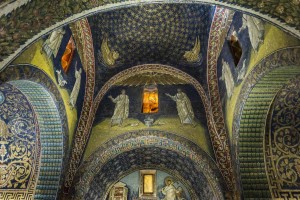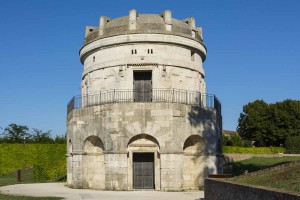
©Bigstock.com/e.della
The Western Roman Empire experienced highly eventful final decades, characterised by a number of different rulers, invasions and an ever-moving capital. Ravenna served as the main imperial residence from 402 to 476 leading to an architectural boom. Eight world-renowned buildings, which were declared UNESCO World Heritage Site in 1996, date back to this era. Let us introduce you to them and show you why these masterpieces of early Christian architecture most definitely deserve this distinction!
Ravenna and the Migration Period
The city near the coast of the Adriatic Sea in the Emilia Romagna had its boom period in the 5th and 6th century as the Migration Period left its mark on Ravenna. Honorius, emperor of the Western Roman Empire, moved his imperial court here in 402 in order to utilise the city’s excellent defensive fortifications. Even though a few regents moved back to Rome for brief periods, Ravenna remained the preferred imperial seat until the ousting of the final Western Roman Emperor in 576. Once the Ostrogoth Theoderic the Great had assumed power in 493 after killing the German Foederatus Odoacer with his bare hands, the city experienced another economic boom. The marks this upswing left on Ravenna still attract visitors from all over the world to this very day.
Mosaics through the ages
One of the main reasons for the lasting glory of Ravenna’s UNESCO World Heritage Sites are the mosaics adorning seven of these eight buildings. They are widely regarded as a show-piece of Western Roman, Gothic and Byzantine art mainly displaying historic and contemporary scenes. Late rulers, however, weren’t too pleased with some of these depictions, which were seen as heretic, yet Ravenna survived the Byzantine Iconoclastic Controversy fairly well as compared to other places. Still, you’ll come across quite a few erased scenes during your tours through the churches, chapels and mausoleums. As an example, a mosaic depiction of Theoderic the Great and his entourage in the Basilica di Sant’Apollinare Nuovo was replaced by Christian characters.
Eight buildings, one World Heritage Site
You’ve read quite a bit on Ravenna’s history and the world-famous mosaics. Now you’re probably wondering where you can see them. No worries, we’ve got you covered and give you a proper introduction to the early Christian monuments that were declared UNESCO World Heritage Site:
Basilica di San Vitale
This architectural showcase is the be all, end all of Ravenna for many visitors: The basilica is part of the impressive complex of the former Benedictine cloister San Vitale and was built in 526 during Theoderic’s reign. Originally, the entire octagonal church was covered with mosaics. Nowadays, only a few examples remain in the presbytery and the apse. Scenes from the Old Testament and the prominently featured imperial couple Justinian and Theodora show genuine grandeur.
Mausoleo di Galla Placidia
Looking behind this basilica, you come across a tomb built for Empress Galla Placidia from 425 onward. Herself, her husband Constantius II and her son Valentinian III were originally buried in Rome before being moved to the mausoleum between the 9th and the 14th century. What makes these late antique mosaics special is the intensely gleaming blue-green background with a night sky, flanked by depictions of disciples and wild animals.
Basilica di Sant’Apollinare Nuovo
Theoderic had an imposing basilica built right opposite his front door in order to properly celebrate his triumph over Odoacer. Sant’Apollinare Nuovo only received its name during the 9th century when the relics of the city’s first bishop were moved inland from Classe. Among other things, the expedited Christianisation lead to several expansions over the following centuries as well as the deletion of supposedly pagan motifs. If you look closely, you can still see some of the original hands and arms behind newer religious displays.
Mausoleo di Teodorico

©Bigstock.com/starmaro
Theoderic’s tomb is the big exception on this list. Why, you wonder? Well, there’s not a single mosaic in sight here. Furthermore, the body of the Ostrogoth ruler is missing with only his empty porphyry sarcophagus remaining. We do not know what happened to his remains. Still, the mighty building made from Istrian limestone is pretty impressive. The cupola alone weighs approx. 300 tons.
Battistero degli Ariani
Back to the mosaics: Those in the octagonal Arian Baptistery are among the city’s best-preserved. The building situated opposite the Arian cathedral Santo Spirito is mostly empty inside except for a baptistery. Your eyes will instead meet the artistic, yet strictly formally arranged mosaics. They feature the first ever depiction of a disciple with a nimbus.
Battistero Neoniano
As opposed to the Arian building, the Baptistery of Neon presents itself decisively more colourful and lively in terms of mosaic design. This is mainly due to the cobalt-blue background virtually shining down from the ceiling. Surrounded by stucco and marble, the cupola will most certainly impress you. A closer look reveals depictions of the twelve disciples and Jesus’ baptism.
Capella e Museo Arcivescovile
This museum with its glorious fabrics, sculptures and sarcophagi from the 5th and 6th century and the imposing Ivory Cathedra awaits you inside the baroque episcopal palace Sant’Orso. The absolute eyecatcher of this exhibition, however, is Theoderic’s private prayer room built during the time of Archbishop Peter II. Awe-inspiring mosaics present the fierce side of the triumphant Christianity.
Basilica di Sant’Apollinare in Classe
The basilica in the suburb Classe is located approx. 5 km outside of Ravenna and was dedicated to Apollinaris, the city’s patron saint. Pillaging and a severe earthquake heavily damaged the ostentatious interior. Still, some of the world-famous mosaics survived these eventful times including those on the apse and the triumphal arch. Sadly, the mosaic floors and the entire marble planking was lost.
Ravenna and its mosaics from early Christian times – an impressive collection of architectural and artistic marvel that even survived natural disasters, pillaging and censorship fairly well. If you’d like to see all of that and even more of the city’s highlights, we recommend the ZAINOO city tour. You’ll stumble across several other amazing constructions and hidden monuments that impressively emphasise why Ravenna is one of the most beautiful places in Italy.